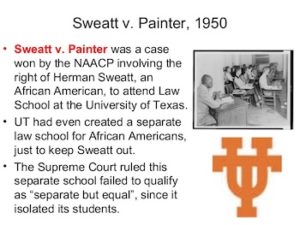
*Sweatt v. Painter, 339 U.S. 629 (1950) was decided on this date in 1950.
This U.S. Supreme Court case successfully challenged the "separate but equal" doctrine of racial segregation established by the 1896 case Plessy v. Ferguson. Four years later, the case was influential in the landmark Brown v. Board of Education case.
The case involved a Black man, Heman Marion Sweatt, who was refused admission to the School of Law of the University of Texas, whose president was Theophilus Painter, because the Texas State Constitution prohibited integrated education. Instead of granting the plaintiff a right of mandamus, the state district court in Travis County, Texas, continued the case for six months.
This allowed the state time to create a law school only for Black students, established in Houston rather than Austin. The 'separate' law school and the college became the Thurgood Marshall School of Law at Texas Southern University (known then as "Texas State University for Negroes").
The Court of Civil Appeals affirmed the trial court decision, and the Texas Supreme Court denied a writ of error on further appeal. Sweatt and the NAACP went to the federal courts, and the case ultimately reached the U.S. Supreme Court. Robert L. Carter and Thurgood Marshall presented Sweatt's case.
Historic U.S. Cases 1690-1993:
An Encyclopedia New York
Copyright 1992 Garland Publishing, New York
ISBN 0-8240-4430-4